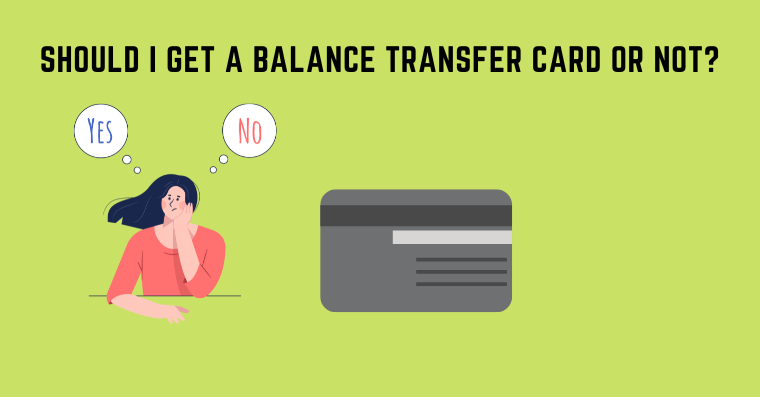Should I Get A Balance Transfer Card Or Not?
Whether or not you should get a balance transfer card depends on your financial situation and goals. A balance transfer card is a type of credit card that allows you to transfer high-interest credit card debt to a card with a lower interest rate, usually for a limited period.

Pros of a balance transfer card:
Lower interest rates:
The main benefit of a balance transfer card is
a lower interest rate on your transferred debt. This can save you a lot of
money in interest charges, especially if you have a large balance and a
high-interest rate on your current card.
Debt consolidation:
By transferring multiple high-interest credit
card balances to a single card with a lower interest rate, you can simplify
your finances and make it easier to keep track of your debt.
Time to pay off debt:
A balance transfer card often offers a
promotional period, usually 12-18 months, during which you can pay off your
debt without accruing interest. This can be a great opportunity to get out of
debt faster and save money in the long run.
Cons of a balance transfer card:
Transfer fees:
Some balance transfer cards charge a transfer
fee, which can range from 3-5% of the amount transferred. This can add up
quickly and offset some of the savings you would otherwise receive from a lower
interest rate.
Short promotional period:
The promotional period during which you can
pay off your debt without accruing interest is usually limited to 12-18 months.
After that, the interest rate on your transferred balance will usually
increase, so it's important to pay off your debt before the promotional period
ends.
Credit score impact:
Applying for a balance transfer card can have
a temporary negative impact on your credit score. This is because the credit
card company will perform a hard inquiry on your credit report, which can lower
your score. Additionally, if you transfer a large balance, it can increase your
credit utilization, which is the amount of credit you're using compared to your
credit limit. Thus, your credit score can also be lowered by high credit
utilization.
Limited credit available:
By transferring your debt to a balance
transfer card, you may limit the amount of credit available on your other
cards, which could be a problem if you need to use those cards in the future.
Considerations:
Creditworthiness:
To be eligible for a balance transfer card,
you typically need to have good to excellent credit. If you have a low credit
score, you may not be approved for a balance transfer card or may only be
approved for one with a high-interest rate.
Debt amount:
If you have a small amount of debt, a balance
transfer card may not be worth the transfer fee or the impact on your credit
score. In this case, it may be better to simply pay off your debt as quickly as
possible.
Repayment plan:
Before applying for a balance transfer card,
make sure you have a plan for paying off your debt during the promotional
period. If you don't have a plan or can't stick to it, you could end up with
even more debt and a lower credit score.
Conclusion
A balance transfer card can be a great way to
save money on interest and simplify your finances if you have good to excellent
credit, a large amount of high-interest debt, and a plan for paying off your
debt during the promotional period. However, weighing the pros and cons and
considering your financial situation before applying for a balance transfer
card is important. If you're not sure if a balance transfer card is right for
you, consider speaking with a financial advisor or credit counselor.
Read More: How to determine Credit Limit



Comments
Post a Comment